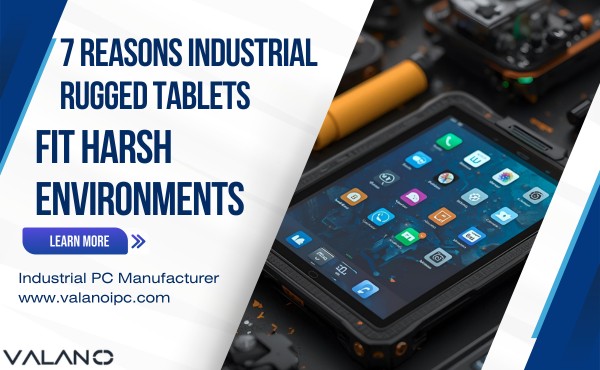When reliability matters in extreme conditions, fanless industrial computers stand out. Designed without traditional cooling fans, these systems use passive cooling to eliminate dust buildup, reduce mechanical failure, and operate silently. Their sealed enclosures protect internal components from debris, moisture, and vibration—common threats in factories, transportation hubs, and outdoor installations.
While conventional PCs struggle in harsh environments, fanless models are engineered for continuous operation in places where downtime isn’t an option. In this article, we’ll explore why fanless industrial computers are the preferred choice for rugged applications and how their design supports long-term stability and durability.
Benefits Of Fanless Industrial Computers in Harsh Environments
Fanless industrial computers were designed with environmental factors in mind, thus having the following benefits:
1. Exceptional Reliability
Systems without internal fans and moving parts have fewer mechanical failures, thus lowering the chances of unexpected downtime.
2. Waterproof and Dustproof Features
Most fanless computers are certified with IP65, IP66, or IP67 ingress protection ratings, which ensures:
- Resistance to small particles of dust.
- Protection from low/high-pressure water jets or temporary immersion in water.
These devices are used in industrial settings such as factories, food processing plants, mining areas, or installations outdoors.
3. Resistance to Shock and Vibration
Fanless computers often include SSDs, which solidify the design and use tough components. The casing is usually made of aluminum or stainless steel, which is rugged in:
- Railway systems.
- Vehicle-mounted systems.
- Machinery platforms with constant shaking.
Many models meet MIL-STD-810G or IEC 60068 standards for vibration and shock resilience.
4. Wide operating temperature range
Like other industrial PCs, fanless PCs are designed to survive extreme heat or cold temperatures. These typically include:
- Low end: -40°C.
- High end: +70°C.
Such tolerances are important for outdoor environments, power substations, and deserts.
5. Noise-Free Operation
Noise-free operation is essential in surveillance systems and office-based industrial control rooms. Fanless PCs do not produce noise, quieting the workspace.
6. Maintenance and Costs
Fanless PCs have no fans that need to be maintained or dusted off. Thus, they are low maintenance. This in turn leads to:
- Fewer system checks.
- Reduced labor costs.
- Lower costs with longer lifecycles and better returns on investments.
Fan-Cooled vs. Fanless Industrial Computers
Fan-Cooled Systems
Internal fans are a standard feature on industrial computers as a means of active cooling. These fans circulate external air and cool internal components like the GPU and power supply. While beneficial in a controlled environment, active cooling comes with the following disadvantages in an industrial setting:
- Dust and Debris Buildup: Fans draw in airborne particles, which accumulate on internal components, leading to heat buildup and performance degradation.
- Moisture Intrusion: Airflow openings provide entrances for moisture, risking short-circuits or corrosion.
- Fan failure: If these mechanical components suffer a malfunction, the entire system becomes susceptible to thermal cutoff.
- Noise: For environments sensitive to sound, the hum of fans may interfere with operations or user comfort.
Fanless Systems
In contrast, fanless industrial computers use passive cooling methods. It is most commonly through integrated heat sinks and thermally conductive materials within a sealed frame. The main characteristics include:
- No Moving Parts: Mechanical failure is minimized.
- Complete Seal: No dust, debris, or moisture can enter the device.
- Passive heat dissipation: Any heat that is generated is released to the housing through natural convectional heat transfer or radiation.
Compared to fan-based computers, systems with these characteristics are more environmentally resistant and reliable, as well as stronger; therefore, these systems are ideal for long-term operation.
Applications of Fanless Industrial Computers
Durability and reliability-seeking use cases include:
- Transportation: It involves railway monitoring, in-train networking, fleet tracking, vehicle diagnostics, and mobile data acquisition in trucks and buses.
- Industrial Automation: It involves the integration of edge computing within automated production lines, connecting controllers, PLCs, and sensors, and monitoring factory environments, both automated and manual.
- Energy and Utilities: The focus is on the automation of power plant control systems, monitoring, and fault diagnostics for pipelines, and remote supervisory control of solar and wind farms.
- Aerospace and Defense: This offers mission and field-ready portable computing, ruggedized laptop units, and chemical-proof seals and enclosures for sensitive electronics.
- Food, Beverage, and Pharma: Cleanroom computing involves using machines that require frequent sanitization and chemical-resistant enclosures for efficient and safe operations.
Limitations for Fanless Industrial Computers
1. Thermal Management Challenges
Fanless systems rely on passive cooling, meaning they use heat sinks and conduction instead of active airflow. This limits their ability to dissipate heat, especially in high-performance applications. When the system is under heavy load or placed in a high-temperature environment, thermal throttling can occur, reducing performance to avoid overheating.
2. Limited Processing Power
Because of heat constraints, fanless industrial PCs typically use low-power CPUs. This limits their ability to handle resource-intensive applications like real-time video processing, advanced AI models, or complex automation systems. For high-demand tasks, a fan-cooled or hybrid system may be more suitable.
3. Restricted Expansion Options
To maintain sealed, dust-proof enclosures, many fanless models offer limited I/O ports and few or no PCI/PCIe expansion slots. This can be a bottleneck if your application requires additional GPU cards, I/O boards, or specialized interfaces.
4. Enclosure Design Constraints
Fanless units often require aluminum housings with integrated heat sinks, which increases size and weight. These rugged designs are essential for heat dissipation but may not be ideal for compact installations or mobile use cases.
Conclusion
Fanless industrial computers are purpose-built for harsh environments where dust, vibration, and extreme temperatures can damage conventional systems. Their sealed, fanless design eliminates airflow pathways that typically attract contaminants, ensuring longer operational life with minimal maintenance. With no moving parts, these systems are more resistant to shock and mechanical failure.
Passive cooling through rugged enclosures maintains stable performance even in challenging conditions. While they may not suit high-performance applications, their reliability and durability make them the ideal choice for industries like manufacturing, transportation, and outdoor automation. When reliability under stress matters, fanless systems offer a proven, cost-effective solution.









